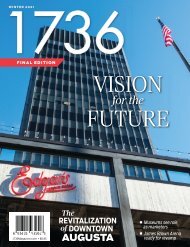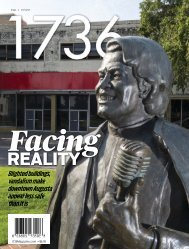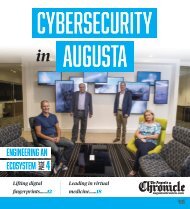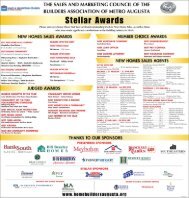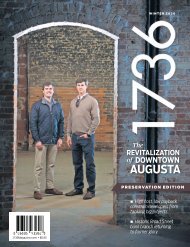1736 Magazine - Fall 2018
You also want an ePaper? Increase the reach of your titles
YUMPU automatically turns print PDFs into web optimized ePapers that Google loves.
A COORDINATED<br />
EFFORT<br />
Downtown organizations need to speak with<br />
‘one voice’ to revitalize urban core<br />
Robert C. Osborne<br />
President, Augusta Tomorrow Inc.<br />
Augusta Tomorrow is in a unique position<br />
of being able to look back and<br />
see where Augusta was almost 40<br />
years ago and how far it has come.<br />
As an early pioneer in public-private<br />
partnerships, Augusta Tomorrow<br />
has acted as the private sector’s main advocate<br />
for urban change since its formation in 1982.<br />
Like many American cities, Augusta’s downtown<br />
began losing its allure when suburbs became<br />
popular. The real blow to downtown Augusta<br />
came in 1978 when the Augusta Mall and<br />
Regency Mall opened within a week of each other.<br />
The central business district soon became a shell<br />
of its former self.<br />
For a community to prosper, it needs a strong<br />
core, and downtown Augusta is the heart of a<br />
metro area we know as “Augusta River Region.”<br />
With Augusta Tomorrow representing the<br />
private sector, its targeted master planning efforts<br />
during the 1980s and 1990s resulted in the<br />
realization of major revitalization efforts such as<br />
Riverwalk Augusta, the Augusta Riverfront Center<br />
complex, the Augusta Common and Springfield<br />
Village Park.<br />
In contrast to downtowns of old, city centers<br />
have emerging as unique environments where<br />
people can live and work, often without having to<br />
step inside a car. Millennials and baby boomers<br />
nationwide are embracing the opportunity to have<br />
dining and recreation within walking distance of<br />
where they live and work.<br />
Until a few years ago, downtown Augusta was<br />
on a path of slow but steady revitalization.<br />
But then came the merging of Augusta State<br />
University and Georgia Health Sciences University<br />
in early 2013 to create the state’s newest research<br />
institution: Augusta University. Later that year,<br />
the Army selected Fort Gordon as the home of<br />
Army Cyber Command by 2020-2021.<br />
Those events have helped spur massive development<br />
throughout downtown, most visibly<br />
at AU’s Riverfront Campus, where the state of<br />
Georgia is building the $100 million Georgia Cyber<br />
Center.<br />
Two new hotels are being built in downtown.<br />
The Medical Districts’ health care facilities continue<br />
to thrive and grow. North Augusta’s bold<br />
vision to expand Hammond’s Ferry into Riverside<br />
Village, a multi-use complex along the Savannah<br />
River that will feature a new hotel, restaurants,<br />
housing and the Augusta GreenJackets’ new stadium.<br />
Unisys has moved a major network operations<br />
center into Augusta’s downtown and other information<br />
technology companies are doing the same<br />
by renovating old buildings into high-tech offices.<br />
Our public school systems are getting on-board<br />
by offering cyber classes at the elementary level.<br />
Augusta’s revitalization is no longer slow and<br />
52 u <strong>1736</strong>magazine.com



